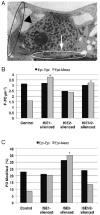Loss of INCREASED SIZE EXCLUSION LIMIT (ISE)1 or ISE2 increases the formation of secondary plasmodesmata
- PMID: 20434343
- PMCID: PMC2902234
- DOI: 10.1016/j.cub.2010.03.064
Loss of INCREASED SIZE EXCLUSION LIMIT (ISE)1 or ISE2 increases the formation of secondary plasmodesmata
Abstract
Plasmodesmata (PD) transport developmentally important nucleic acids and proteins between plant cells. Primary PD form during cell division and are simple, linear channels. Secondary PD form in existing cell walls after cell division and are simple, twinned, or branched. PD function undergoes a marked reduction at the mid-torpedo stage of Arabidopsis embryogenesis. Two mutants, increased size exclusion limit (ise)1 and ise2, fail to undergo this transition, and their null mutations are embryonically lethal. We investigated the ultrastructure of PD in early-, mid-, and late-torpedo-stage embryos and in young leaves. Wild-type (WT) embryos contain twinned and branched (T/B) PD at all stages, but ise1 and ise2 embryos contain significantly higher proportions of T/B PD than WT embryos. WT T/B PD formation occurs in a stage- and tissue-specific pattern that is reversed in ise1 embryos. Silencing ISE1 in Nicotiana benthamiana leaves increases the frequency of secondary PD in existing cell walls. Silencing ISE2 increases the proportion of T/B secondary PD formed. Silenced tissues exhibit increased PD-mediated movement of green fluorescent protein tracers. Thus, silencing of ISE1 and ISE2 phenocopies ise1 and ise2 mutant embryos: when wild-type ISE1 and ISE2 functions are lost, de novo production of PD occurs, leading to increased intercellular transport.
2010 Elsevier Ltd. All rights reserved.
Figures




Comment in
-
Plasmodesmata formation: poking holes in walls with ise.Curr Biol. 2010 Jun 8;20(11):R488-90. doi: 10.1016/j.cub.2010.03.047. Curr Biol. 2010. PMID: 20541498
References
-
- Cilia ML, J D. Plasmodesmata form and function. Current Opinion in Cell Biology. 2004;16:500–506. - PubMed
-
- Lucas WJ, Lee JY. Plasmodesmata as a supracellular control network in plants. Nat Rev Mol Cell Biol. 2004;5:712–726. - PubMed
-
- Kim JY. Regulation of short-distance transport of RNA and protein. Curr Opin Plant Biol. 2005;8:45–52. - PubMed
-
- Zhu T, O'Quinn RL, Lucas WJ, Rost TL. Directional cell-to-cell communication in the Arabidopsis root apical meristem II. Dynamics of plasmodesmatal formation. Protoplasma. 1998;204:84–93.
-
- Oparka KJ, Roberts AG, Boevink P, Santa Cruz S, Roberts I, Pradel KS, Imlau A, Kotlizky G, Sauer N, Epel B. Simple, but not branched, plasmodesmata allow the nonspecific trafficking of proteins in developing tobacco leaves. Cell. 1999;97:743–754. - PubMed
Publication types
MeSH terms
Substances
Associated data
- Actions
Grants and funding
LinkOut - more resources
Full Text Sources
Molecular Biology Databases

